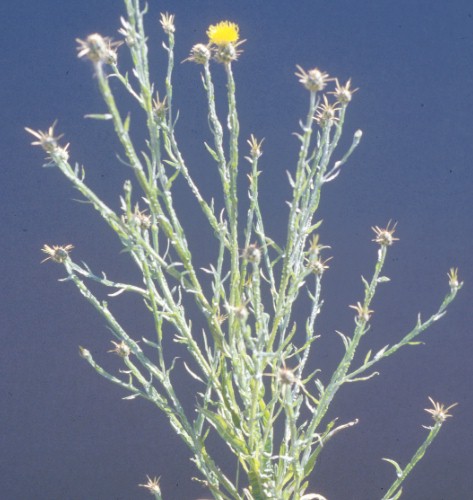|
Description:
Yellow Starthistle is a winter annual plant that
can range from 10 inches to over 6 feet in
height depending on growing conditions.
Fall-germinated seeds quickly develop in
deep-rooted rosettes of bright green, deeply
lobed leaves shaped like an arrowhead. They grow
from 6 to 8 inches long and 1 to 2 inches wide.
Plants produce single or multiple branches that
have matted hairs giving the plant a gray-green
color. The stem leaves are small and linear with
smooth edges and sharply pointed tips. The leaf
blades extend down the stem giving it a “winged”
appearance. A single, bright yellow flowerhead
armed with 1-inch stiff thorns is produced on
the end of each branch. Both plumed and unplumed
brown seeds are produced in each flowerhead.
|
 |
|
Management
Guidelines:
Type and Class of
Livestock:
All classes of sheep, goats, and cattle.
Grazing Objective:
Graze heavily at least twice each year to
prevent flowering and for several years to
deplete seedbank and reduce plant density.
Growth Stage for
Treatment:
Sheep and goats will graze yellow starthistle in
all growth stages. Cattle will graze in the
rosette to bolting stage but will avoid the weed
beyond the late bud stage. Two or three
treatments are needed if grazed in the rosette
or bolting stage; grazing during or after
flowering with goats may require only one
treatment per year.
Potential Effectiveness:
Targeted grazing to control yellow starthistle
is strongly recommended for sheep and goats,
less so for cattle. Goats are probably the most
effective livestock to use for grazing of yellow
starthistle because they will readily eat the
plant in all growth stages. Grazing reduces
plant vigor and plant size and suppresses flower
production. Effective control depends on the
prevention of flower and seed production, which
can be achieved by grazing at least twice a year
over several years. Yellow starthistle is highly
toxic to horses. |
|
References:
Exotic Pest Plant Council. 2006. Yellow
starthistle management with grazing, mowing, and
competitive plantings. California, UC Davis.
Available at:
http://ucce.ucdavis.edu/freeform/ceppc/documents/1996_Symposium_Proceedings1824.pdf.
Accessed 12 July 2006.
Olson, B.E. 1999. Grazing and weeds. In:
R.L Sheley, and J.K. Petroff [EDS.]. Biology and
management of noxious rangeland weeds.
Corvallis, OR: Oregon State University Press, p.
85-96.
Popay, I., and R. Field. 1996. Grazing animals
as weed control agents. Weed Technology
10:207-231.
Thomsen, C.D., W.A. Williams, M.R. George, W.B.
McHenry, F.L. Bell, and R.S. Knight. 1989.
Managing yellow starthistle on rangeland.
California Agriculture 43:4-6.
Thomsen, C.D., W.A. Williams, M. Vayssieres, F.L.
Bell, and N.M.R. George. 1993. Controlled
grazing on annual grasslands decreases yellow
starthistle. California Agriculture
47:36-40.
Thomsen, C.D., W.A. Williams, W. Olkowski, and
D.W. Pratt. 1996. Grazing, mowing and clover
plantings control yellow starthistle. IPM
Practitioner 18:1-4. |
![]()